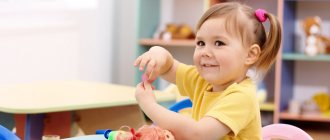Today there are a huge number of different development methods and systems, including non-standard ones, for preschool development and upbringing of a child. Every year - more and more. It is not surprising that this causes a mixed reaction among professionals: there is a Federal State Educational Standard, there are programs, what other “lettergrams” and “spiritual approach to the development of a child’s free personality”? There is definitely a subject for debate. Our expert Marina Bolotova, the scientific director of preschool educational organizations, has carefully studied many popular and original modern methods due to her work. This article is a specialist’s answers to the TOP 5 alternatives to the classical approach. So as not to miss the important things behind the emotions.
All the methods we talk about in this article are focused on the environmental approach: the child is in a specially organized environment that best satisfies the child’s needs.
Montessori pedagogy
Technology invented by teacher Maria Montessori. Initially, she conceived the approach to work with “special” children, but then transferred it to everyone else. The main idea of the approach is that every child has a powerful potential for development; you just need to create conditions using a special environment and not disturb the child.
What principles does it work on?
- A special environment is created, divided into five zones. Practical for the development of everyday skills, sensory with toys of different shapes, sizes, colors, mathematical for the development of counting skills and familiarity with geometric shapes and symbols, language zone for learning letters and syllables, space zone for getting to know the outside world and the mysteries of nature.
- Classes are held in different age groups. Older children interact with younger ones: they pass on their skills to the younger ones and not only teach them, but also develop their skills even better.
- Teachers do not impose or forbid anything on the child - he makes the choice to play with dolls, draw or jump and run. The teacher only presents the material and reveals it as much as possible.
What goals does the child achieve?
- Learns independence. Free choice of activities also develops self-confidence and self-confidence.
- Learns to respect others. Children work and play quietly to respect the time and space of others. You can let off steam in a special “motor” zone. Children also clean up toys after themselves and follow the principle “whoever takes it first gets to play.”
- He studies mathematics, learns about nature and culture. This is helped by working in different zones.
- The teacher must respect children and their choice: give them the opportunity to play and choose the pace of classes.
- The teacher must be able to create an environment. Many toys are made by hand from natural materials.
- The teacher must be able to captivate children. It is he who presents materials for games and activities, and he serves as a model in group creative activities.
Experts analyzed the most popular methods of early childhood development
Psychologists and teachers note that modern parents are literally obsessed with the early development of their children. And, unfortunately, very often such fanaticism does not bring benefit to the child, but real harm. Literally from the age of 2–3 years, adults begin to drag their children to various clubs or try newfangled techniques on them, trying to cover everything and everyone. At the same time, parents often do not notice what their child’s true talent is, and do not allow their children to choose and develop harmoniously in the direction they need.
“Modern parents very often depend on the current fashion for education and aimlessly try to follow it,” says child psychologist Alena Krutitskaya. — For example, teaching a baby to read from a cradle or doing math competitions with him on the potty. As a result, classes become narrowly focused, which is not at all beneficial for any child. In fact, any early development system in one way or another involves varied activities with the baby. In preschool age, it is almost impossible to understand what the talent of a particular child is, so you need to give him the opportunity to develop harmoniously in completely different directions. Of course, none of the existing pedagogical systems of early development is ideal. In my opinion, having an idea of the main ones, parents can create their own program that is suitable specifically for their child.
According to teachers and psychologists, modern parents should know the basic methods of child development created by teachers from different countries. From them, you can always choose a method that suits the family’s spirit and needs, or even use elements and advice from different systems in raising your child. Perhaps, in the end, through trial and error, one of the adults will be able to create their own system for educating a genius. It’s no secret that the authors of early development methods were people of completely different professions.
Montessori method
Age : 0–12 years
Motto : “Help me do it myself!”
Maria Montessori's method has remained one of the most popular early development systems for many years. In Russia, it is most often used by parents for independent activities with children, and is also widely practiced in private kindergartens and schools. The essence of this method is to provide the child with complete freedom in cognition and development. The system does not imply any rewards or punishments, that is, an evaluation system, and does not force the child into a certain framework. Parents and teachers intervene in the process only when the child really needs help. At the center of the educational system is always the child, who is completely free in his development.
The Montessori system involves educating children in rooms conditionally divided into thematic zones that can be organized in an ordinary apartment: life practice, sensory development, mathematical development, language development and cosmic development (natural science knowledge). Each thematic zone should contain special aids that help children gain knowledge on their own. Particular attention in the method is paid to the development of the child’s sensory and sensorimotor abilities, since they are the ones who most influence mental development.
Despite its great popularity, this method also has many opponents. In particular, speaking about this system, many remember that its author, Maria Montessori, sent her own son to a boarding school immediately after birth and did not raise him. The mother first met her son only when he became an adult. However, this did not stop Montessori from achieving amazing success in raising other people's children, including the mentally retarded, with whom she worked early in her career.
Photo: en.wikipedia.org
Pros : the child learns independence from an early age, masters self-service skills earlier than his peers, is free in his actions, and therefore often develops faster, mastering more complex material earlier than other children.
Cons : after training in the Montessori system, it is much more difficult for children to get used to learning in a traditional school; in addition, the methodology pays virtually no attention to the creative development of the child, and there are no role-playing games. The system is more suitable for open and sociable children; it is difficult for closed children to study it.
Parents' opinion:
Valentina, mother of girls the same age: “Before school, we practiced this method at home on our own, and I really liked it. The girls really developed faster than the majority of their peers, and their interests were very diverse: music, drawing, and natural science experiments. We did not bother with traditional preparation for school, and this became our main mistake. Our daughters are used to doing what they like, so when in the 1st grade we had to strictly follow the teacher’s instructions, it was very difficult. The girls were able to fully get used to the traditional system only after a year. So I think that in general the Montessori method is good, but it makes sense to use its individual elements in a child’s development, not forgetting that later the children will have to study in a traditional school. In fact, this system is most effective for preschoolers.
Waldorf technique
Age : 0–16 years
Motto : “Experience the world without coercion!”
The Waldorf pedagogical system is based on religious-mystical (anthroposophical) ideas about methods of self-development through thinking. Most often, this education system is used by parents when educating their child at home and is practiced in private schools. The essence of the method is that the child should explore the world freely and naturally, without coercion from adults. According to the Waldorf method, a child under 7 years old should not be loaded with unnecessary information at all, and in elementary school it is not customary to evaluate a student’s learning outcomes with traditional grades.
The core of learning using this method is a love of nature and the surrounding world. Children use products made from natural materials, such as a leaf of wood, pine cones, or an ice cube, as toys and educational materials. The main principle of the system is respect for the child’s personality and an individual approach to each child. Within the system, there is a ban on the word “no” from adults; it can only be used when a child can hurt himself or others, that is, when his actions are dangerous. In other cases, the child is allowed almost everything, and adults should not interfere in the process of his understanding of the world.
Creativity plays a big role in Waldorf schools; all aids, in one way or another, should stimulate a creative impulse in all children. At the same time, this system completely denies the idea of early child development; It is believed that various knowledge should be given to a person only at the age when he has grown to it. Training is not divided into separate disciplines, but is taught in so-called epochs, lasting 3–4 weeks. In general, this system is well suited for home schooling, since even in Waldorf schools, children under 12 years old are taught everything by only one teacher.
Pros : the main emphasis is on revealing the baby’s personality, this allows everyone to show their individuality and reveal themselves; Much attention is paid to teaching crafts: needlework, gardening, etc.; Waldorf children have a good imagination and fantasy, and are passionate about creativity; The technique involves a ban on watching TV.
Cons : it is difficult to assess a child’s level, since the methodology does not involve assessments; transferring to a regular school will be very problematic due to fundamentally different curricula and approaches to learning; the system is more suitable for humanities students, rather than for children with an analytical mindset.
Parents' opinion:
Yulia, teacher, mother of a second-grader: “I work as a tutor at home, so I had the opportunity to teach my son on my own. I heard a lot of rave reviews about the Waldorf system from my colleagues, so I decided to try it on my son. Unfortunately, it didn’t suit my child at all: in six months we hardly got off the ground, he just didn’t want to do anything, even seemingly interesting creative projects and tasks didn’t interest him at all. As a result, I took him in stride and began to teach him the old fashioned way, with “twos” and “threes” for unfinished assignments; soon everything got better. Obviously, the system is suitable for children with a certain creative type of thinking, who do not need to be constantly pushed and pushed into activities.”
Methodology Cecile Lupan
Age : from birth
Motto : “Parents are the main teachers!”
The method of the Frenchwoman Cécile Lupan belongs to the systems of super early child development. Lupan has nothing to do with science or pedagogy and developed her methodology while raising her own daughters. However, her system has consistently found followers around the world for several years now. The main role in this method is given to parents; they should act as the most important teachers and mentors for the child.
From birth, a child should be taught strictly through play, without a specific schedule or overwork. Adults are encouraged to constantly create conditions for the child to make new discoveries and develop curiosity. The Lupan system also involves compulsory swimming training for babies right from birth, immediately after the mother leaves the hospital. Early learning itself is built on constant play. For example, in order for the baby to remember letters and numbers, Cecile suggests composing songs and poems for him based on well-known motives.
The main task of teaching children under one year of age is to stimulate the baby’s five senses; in the second year, the child already learns to put words into sentences with the help of special cards, begins to learn a foreign language, studies geographical maps and tries to remember complex words from encyclopedias. And from the age of 3–4 years, it is expected that the child should begin to master playing any musical instrument and serious sports such as horse riding. The entire Lupan method is laid out in a table that describes in detail how and what to do with a child at different ages. The scale of skills, as a rule, impresses even the most demanding mothers.
Pros : suitable for children of any age and level of development, brings parents and children closer together, in some cases, children who were taught using this method really showed brilliant success in the future.
Cons : requires a lot of time from adults, does not involve active communication between the child and other children, the technique is very overloaded and takes all the time and energy from adults and children, does not involve the development of fine motor skills and sensitive skills.
Parents' opinion:
Ekaterina, mother of 5-year-old twin boys: “In my opinion, this technique has a right to exist and is good for the early development of children. But, in my opinion, one should not strictly follow all her recommendations; often this is simply unrealistic. Every mother will be able to find something interesting and useful for herself in this system and include it in home activities with her baby, everything should be in moderation, then this method will really work. For example, we made our own books with our sons, studied geographical maps, but abandoned the meaningless memorization of encyclopedic terms.”
Masaru Ibuka technique
Age : 0–4 years.
Motto : “After 3 it’s too late.”
Masaru Ibuka is one of the founders and chief engineer of Sony Corporation. The Japanese began studying early development methods because his own son was developmentally delayed due to a serious illness. Based on consultations with famous teachers and psychologists, Ibuka developed his own original method of early child development. The Japanese system says that in reality there are no retarded children, since the development of a child depends only on the child’s education in early childhood.
According to Masaru, the basic knowledge that influences the future and development of a child is acquired by him before the age of 4 years, so it is during this period that as much attention as possible should be paid to activities with the baby. Essentially, a child is a blank slate on which a parent can write or draw anything. At the same time, you need to load your child with information wisely, using a special system. There is absolutely no need to be afraid of overload, since the child’s brain is actually capable of solving very complex problems.
According to the methodology, children should be given paints, plasticine and pencils as early as possible, literally within a few months, introduced to the paintings of great artists and played classical music. In addition, you need to introduce your child to the world not with the help of toys, but with the help of normal adult things. Ideally, by the age of 3, a child should try almost everything in life that is not dangerous to his health.
Pros : the baby is free to choose his own activities and studies, this contributes to earlier development compared to his peers, early learning of foreign languages, music and drawing gives impressive results in the future.
Cons : the technique is designed for children with an eastern mentality, obedient and inclined to contemplation; a child in this system is allowed almost everything, so parents will have to regularly tidy up the apartment after destruction.
Parents' opinion:
Alexander, father of many children: “Unfortunately, it is not easy for European people to use this method for raising children simply based on Ibuki’s books. There is a lot in the system that is incomprehensible to our mentality; there is often a reference to the fact that parents should ideally feel what a child should do at a given age. But not everyone succeeds in this, especially with their first child. We settled on the fact that in raising our children we used only some advice from the Japanese, including introducing him to the world with the help of objects that are actually used by adults.”
Glenn Doman Method
Age: 0–5 years.
Motto: “Training the brain from birth.”
This technique has long been very popular among parents who dream of raising geniuses literally from the cradle. Moreover, the system was initially created by an American physiotherapist for children suffering from brain disorders. After a while, it turned out that the technique works great when teaching healthy children. Glenn Doman believed that a child’s brain needs to be actively trained from birth, otherwise by the age of 5–6 years it will be difficult for children to learn and remember information. The fact is that during the period of active growth up to 2–6 years, the child’s brain is aimed at cognition; the baby does not yet need to have motivation for learning.
In the Doman system, the child is offered certain drawn cards with words, dots (mathematics) and pictures (the world around him), thanks to which children learn to remember words, read and count. It is recommended to show your child pictures literally from birth, naming them loudly and clearly. Such actions form even in an infant a clear connection between what he hears, sees and perceives as a whole.
In addition to cards, the Doman system also involves special creative and physical development of the child. Doman recommends introducing children to various sports as early as possible: swimming, skiing, skating, running, etc. It is believed that if you start studying with a child using this system from the first month of life, by one year he will already have a significant vocabulary, and subsequently will be able to quickly read and count and easily remember a large amount of information.
Pros : training using the method does not take much time, the system is clear, simple and accessible to any parent.
Cons : the system is aimed at developing visual memory, but does not involve the development of tactile skills, and is only suitable for diligent children.
Parents' opinion:
Oksana, mother of a second-grader: “I studied this method with my daughter until she was three years old, and it really worked. At the age of 4, my daughter had already learned to read and count well. Now she has no problems with learning, we were even taken straight into 2nd grade, bypassing first. I showed the cards to my daughter when she was 3 weeks old, but we spent significantly less time on them than was originally allotted according to the system. From half an hour a day in the first year of life to an hour at 2–3 years of age. Of course, in addition to the Doman system, we also used other training models, so now it’s difficult to say what exactly influenced the result.”
Nikitin's technique
Age: 0–16 years.
Motto : “Mom, Dad, I am a sports family.”
Boris and Elena Nikitin are innovative teachers and parents of seven children. From their own experience, they created a unique system for the early development of children.
The essence of the technique is complete freedom of action for the child. There are no systematic classes or other restrictions. Children can exercise as much as they want, at a time that is convenient for them, combining sports and intellectual activities. The technique involves hardening the baby from an early age, children need to be dressed in light clothing, they should spend as much time as possible in the fresh air. Sports come first in this method; from early childhood, children learn to use various sports equipment, which become for them as integral a part of the interior as furniture.
The center of the system is parents, who, by their own example, teach their children to a healthy lifestyle, hardening and training. The task of adults is to communicate with children as much as possible, to encourage and praise them in every possible way. At the same time, the method does not accept coercion; the child must do everything joyfully without coercion. Of course, the methodology assumes that all family members should be passionate about sports and follow the rules of a healthy lifestyle.
Pros : pays sufficient attention to both the intellectual and physical development of the child, is easy to use, can be used by parents who are far from pedagogy.
Cons : there is no individual approach to the child, there is no creative component and elements of the development of fine motor skills, it assumes a radical approach to hardening the baby, the usefulness of which from a medical point of view is very controversial.
Parents' opinion:
Polina, mother of many children: “What interested me most in the Nikitins’ method was the system of hardening children from birth. Due to my inexperience in this matter, I missed my first child, but I began to harden the two younger ones literally immediately after being discharged from the maternity hospital. The result was amazing; unlike the eldest daughter, the younger ones practically did not get sick either in kindergarten or at school. In addition, doctors have always identified children’s health group as first, which is considered a rarity these days.”
Methodology “School of the Seven Dwarfs”
Age: 0–6 years.
Motto : “All the best - in one bottle.”
The School of the Seven Dwarfs, in fact, combines elements of many popular pedagogical methods. It is based on six pillars: mental, physical, emotional, aesthetic, personal and social development. Special books, divided by age, touch on all these areas of child development in one way or another.
The School of the Seven Dwarfs teaching aids consist of 12 books for children aged 0 to 6 years. With their help, the child gradually masters information, including learning to make various crafts, glue and cut, which contributes to the development of fine motor skills.
Pros : you can practice the method yourself, it is clearly systematized, each book has clear instructions for parents, and incentive prizes in the form of stickers are provided for children.
Cons : not all books are equally well made, some have not very good tasks and drawings, the brochures are clearly distributed by age, children are not interested in going through books for older children.
Parents' opinion:
Elena, mother of a first-grader: “We studied this method before school, in general it’s quite good. True, it did not seem to me that this technique contributes specifically to the early development of a child in its classical sense. Rather, this is a good help for parents for step-by-step lessons with their child at different ages and his further preparation for school.”
Methodology of Vyacheslav Voskobovich
Age: 2–16 years.
Motto : “Development is in the game!”
In the early 90s, when former Soviet citizens had problems purchasing high-quality and inexpensive toys for their children, physicist engineer Vyacheslav Voskobovich created the country's first system for developing thinking based on educational games. All games are multifunctional and can be played many times in different combinations. During the game, children, with the help of their parents, learn to read and count, think logically; in addition, their imagination and fantasy develop.
Most games come with teaching aids, illustrated by famous fairy tales, with the help of which children perform various tasks and answer questions.
Pros : Vyacheslav Voskobovich’s games arouse great interest in almost all children; constant lessons in the system contribute to the development of memory, attention and thinking, the ability to analyze a large amount of information and the development of spatial imagination.
Cons : Voskobovich's games are very difficult to make yourself, for classes you will have to purchase them in special stores, in addition, the system is not complete for the harmonious development of the child, the games will have to be combined with other activities.
Parents' opinion: Artem, father of a preschooler: “My parents played Voskobovich’s games with me as a child, it seems to me that they had a great influence on my development and ability for analysis and logical thinking. Already in elementary school, I was good at complex problems for higher grades, and I went to study mechanics and mathematics at Moscow State University. Now I’m already using this system with my own son, I hope it will help him too, although these days there are a lot of similar games by other authors.”
Reggio pedagogy
Italian technology, based on the ideas of Vygotsky and Maria Montessori. The author of the technology is Loris Malaguzzi. Malaguzzi believed that the child had at least 100 languages, but 99 of them were stolen. Much in a child’s life happens at the direction of adults, even holidays. The main postulate is that the environment must meet the needs and capabilities of the child.
What principles does it work on?
- A separate program includes space for the child. He can even retire and do only what he wants.
- The parent is completely immersed in the work of the kindergarten. He sometimes goes to kindergarten with the child, helps, and becomes a partner.
- There is no assessment and control - no final tests. The Reggio teacher uses observation, records the results of the child’s work, but does not give an assessment.
What goals does the child achieve?
- Learns partnership. Children are taught to work in groups so that they learn to negotiate, cooperate, and get used to the fact that they are “not alone.”
- Studies culture. Classes are not limited to the kindergarten environment: children are taken on excursions, helped to understand relationships between people, the rules of society, and traditions.
- Learns free choice. The child himself chooses the pace of classes and the materials with which he will play.
What should a teacher be like?
The teacher must follow six rules:
- Respect the child and look him in the eye.
- Explain the rules and ask a question. Only this way, and not the other way around.
- Not “wrong”, but “different”.
- Offer choice and don't rush.
- Learn in any situation.
- Fantasizing is more important than reading.
Zaitsev's technique
Nikolai Aleksandrovich Zaitsev is a St. Petersburg teacher who came up with a popular system for teaching reading by syllables. In his opinion, it is the syllable that is the elementary part of speech, and not the word or letter. When a child just begins to speak, he pronounces the syllables “ma”, “da”, “ka”, “ba”. The artificial division of syllables into letters strengthens children's speech skills and causes difficulties with reading.
The development system of a child up to one year is based on visual aids - cubes and cards. It also involves learning fun, short songs, the singing of which helps you learn the material faster. The basic principle of development is play as the main activity of young children.
It is optimal to start working with children according to Zaitsev’s program after 1.5-2 years. You can study earlier than other children, but as practice shows, the older the child, the faster he learns to read. For example, if a two-year-old child begins to read after 6 months, then a five-year-old child begins to read after 2 weeks.
Although there are 7 times more syllables than letters, learning them is not difficult at all. Along with reading, children master literate writing. For example, they immediately remember that “zhi” and “shi” are written with “i”. Moreover, during classical learning to read letters, preschoolers are often distracted by drawings. The cubes contain only letters, without distracting elements.
In this method of development, the child receives the following benefits:
- Learn to write without mistakes;
- Avoids speech therapy deficiencies;
- Learns to speak clearly;
- Expands vocabulary;
- Develops logical thinking;
- Trains visual memory.
Practicing according to Zaitsev’s early development method is very simple. You need to purchase ready-made blocks and organize short lessons at a time convenient for the child. He must be healthy, in a good mood, rested. There should be no forced training. It is important to interest the child, then the training system will give the best results. After learning the syllables, you can learn to read signs.
Voskobovich games
Educational games created by physicist-engineer Vyacheslav Voskobovich. They represent a developing environment of different zones and elements, united by one fairy-tale plot.
What principles does it work on?
- It is based on three principles: interest, knowledge and creativity. This builds cognitive and research skills.
- Games are developed in accordance with the interests of the children. Each can be used by children from 2 to 7 years old; for younger children the tasks are simpler.
- The developmental environment “Purple Forest” has been developed for games, with several zones in which the child fulfills certain needs.
What goals does the child achieve?
The main goals of technology are learning new things, developing the ability to observe, building confidence, a harmonious approach to the development of emotionality, imaginative thinking and logic.
What should a teacher be like?
- The teacher must understand the material: know the games, be able to build a plot.
- The teacher must involve the children in the game; some time must be spent getting to know its rules.
- The teacher does not evaluate the completion of assignments. Each age has its own level; if you can’t cope, you can move on to an easier one.
How to form a bond with your baby?
Most mothers intuitively feel what is best to do to make their child feel good. And if some time ago the word “routine” was heard everywhere (feeding by the hour, sleeping in a crib according to a schedule), forcing mothers to turn a blind eye to their intuition regarding the child, now attention is paid to the needs of the baby. How can we make the mother-child connection stronger?
- Don't give up breastfeeding . Some mothers are afraid of pain, sagging breasts, and do not want discomfort. But, if you have milk, try to save it and breastfeed your baby. The strongest connection between a child and his mother occurs precisely through breastfeeding.
- Hold your baby in your arms more often. Tactile contact with parents is important for the baby. Just recently he was in a comfortable place where he felt warm, soft and calm. And now he is in an unknown environment, where everything is completely different. Imagine how stressful this is for a little person. Right now he needs his mother's touch. And when the mother hugs the baby close to her, he feels the familiar heartbeat, the warmth of soft hands and calms down.
- Carry your baby as much as possible. When physical contact with the mother is maintained, the baby is much more comfortable. In addition, there is currently a wide variety of devices for carrying a baby.
- Sleep together . Sleeping “sideways” with the mother is beneficial for the newborn from a psychological point of view. And this is very convenient for the mother herself - night feedings will not be accompanied by a long cry from the baby until you finally take him and put him to your breast. There are opponents of this method of education, who claim that it can spoil the child. But how can you spoil a newborn? It is when he finds himself in an unfamiliar environment, where there is no cozy warm tummy, that sleeping next to his mother will help him quickly adapt to changes in his life.
- Respond to your child's call. If the baby is crying, then something is wrong. He is hungry, cold, hot, wet, anxious. He needs his mom. And by responding to his crying as quickly as possible, you will not spoil him in any way. Just help him not to form such a habit when he begins to get what he needs through persistent crying or screaming.
- Communicate with your baby. Even if it seems to you that he doesn’t understand anything and doesn’t even listen to you, communicate with him. Talk about what you are doing, read nursery rhymes, sing songs and lullabies. Don't be shy about your funny voice and outside appearance. All the sounds that he hears have a great impact on the child’s neuropsychic development.
The connection between a child and his parents, established in infancy, remains for life and gives the child confidence that he is loved and will not remain helpless in various situations.
Amazing fact. The closer the communication between mother and child in the initial period of its development, the easier it will be for the baby to develop independence. Communication with the mother helps the child feel protected and knows that the mother will always come to the rescue. Therefore, he explores the world more actively and tries to do something new. And that is why over time he begins to do something without the help of his parents.
The same applies to discipline. Confidential communication between a child and his parents makes it easier to learn discipline. Using their example, it is much easier for parents to show their child what and how to do correctly, because they are an authority for him.
And do not forget that both parents should communicate with the child. The role of the father in raising a child is no less important than the role of the mother.
Dewey technology
John Dewey developed a practice-oriented approach. Dewey believed that a preschooler should engage in play and work activities, which gives him the necessary life experience.
What principles does it work on?
- Everything that happens to a child must be practically oriented. There is no need to overload the brain with unnecessary knowledge; you need to teach how to work with your own hands, and apply acquired knowledge and skills in other situations.
- Education should be aimed at gaining experience, which can only be accumulated by the child himself. Thinking is only a tool for solving problems. The child explores the world around him and ultimately wants to learn the necessary skills and experience them.
- In addition to work skills, geography and history are important. Geography helps to learn about the world around us, history helps us learn about the world and culture of people.
What goals does the child achieve?
- Gains life experience. The child learns to solve problems and develops skills.
- He understands geography and history. This helps to understand the world around us and people with their relationships.
- Learns to be entrepreneurial. This is facilitated by the projects that the teacher launches with the children.
What should a teacher be like?
- Must have strong instrumental skills, such as working with hands. Without this, he will not teach the necessary skills to children.
- Does not compare children with a friend - competition is prohibited in technology. The child is compared only with himself.
- Teaches children project activities. Projects help children gain experience and learn skills, as well as collaborate with others and develop their own entrepreneurial spirit.
Raising a newborn. Where to begin?
There are several rules that must be followed in order to lay the foundations for the proper upbringing of a child.
- Have a positive attitude towards your new life role . Now you are parents. And only when you fulfill your parental responsibilities with pleasure, a joyful atmosphere of warmth and tranquility will reign in your family, which is very important for the formation of a healthy psyche of the baby.
- Learn to understand what the child needs . It will be difficult at the very beginning. The baby cannot talk, and his crying does not yet have the shades that the mother will be able to distinguish after some time. It is important to respond to a child’s crying, because this is his way of showing that he needs something. Over time, you will learn to quickly determine what exactly he wants.
- Create a strong bond with your baby . This is perhaps the most important rule. The baby's connection with his mother begins to form from the first minutes of his life, when he receives the first drops of valuable colostrum from the mother's breast. And in order for the child to develop, grow healthy and feel comfortable, it is necessary to maintain this connection.
Maria Montessori – comprehensive education
One of the most common techniques that parents have been successfully using for several decades. The main idea of a Montessori school is that children need to be taught writing before other skills: counting, reading. The central place in this pedagogical concept is occupied by His Majesty the child. In a specially organized environment consisting of several zones (mathematics, sensory, creative, speech, etc.), children improve skills that correspond to their age and acquire knowledge from their own experience. An adult watches the game process, offers children the necessary materials and toys (but does not impose them), thanks to which they can develop comprehensively. By the way, this technique is aimed not only at cognitive development, but also at developing work skills and respectful attitude towards other people. In detail Maria Montessori's method: advantages and disadvantages
READ ALSO: Is it necessary to teach a child to write before school?
Jean Ledloff - natural education
Psychotherapist Jean Ledloff spent several years with the Yequana Indians and became imbued with their educational traditions. These people were truly happy, did not experience negative emotions, and their children cried very rarely. Returning to her homeland, Jean discarded Western ideas about education and wrote an unusual and controversial book on natural development, “How to Raise a Happy Child.” The point of this method is to be with the baby constantly in the first months, and in the future not to interfere with the formation of an independent personality: not to control, not to sink to his level, but to be a model of behavior for him.
Parenting in a family using the Nikitin method
The Nikitin family clearly demonstrates children who are in many ways ahead of their peers in development. The result is successful studies at school with an accelerated program, physical perfection in performing all kinds of exercises. On the other hand, there is dislike and envy of peers, and a certain misunderstanding, and sometimes condemnation, of others.
Having eliminated fanaticism and the desire to make a genius out of a child in any way, you will find a successful arrangement and create your own method for your child. And remember, no matter what degree of development your child has, the main thing is that he feels that he is loved.
DIY crafts for children and adults - here. What you may need soon are autumn crafts, crafts made from natural materials, original crafts from vegetables and fruits.
Shalva Amonashvili – humane pedagogy
Doctor of Psychological Sciences, Professor Amonashvili developed his own pedagogical concept based on a humane approach to preschoolers and schoolchildren. The main principle of the method is that the adult must cooperate with the child on equal terms and see him as an individual. This technique is finding more and more supporters, as it is truly special. The author does not offer a ready-made list of exercises for developing a separate ability or skill, but a list of rules that teachers and parents need to follow. According to the famous psychologist, a child will achieve better results if he is not forced or controlled. There are no bad children, there are adults who do not know how to communicate with them.
Dr. Suzuki's method
Violinist and teacher Shinichi Suzuki believed that all children are naturally talented, so this should not be ignored. If children are surrounded by pleasant music and classical works, this will help them become wonderful, kind and open people.
How to raise children using this method
Sh. Suzuki believed that if a child begins to talk by being completely immersed in his native speech, then by the same principle one can surround him with music and unleash his creative potential.
Basic provisions of the methodology:
- The baby should listen to music from birth, and from the age of two you can teach him to play musical instruments;
- You can send him to a music school when he begins to show a real craving for art;
- work should take place in groups of 3-4 people, so that everyone has the motivation to follow the others;
- The repertoire is carefully selected for each musical instrument so that skills develop gradually.
Advantages and disadvantages
Advantages:
- the method is based on internal motivation, so the likelihood that learning music will get boring is minimal;
- can be tested on any child, because everyone has talent;
- can be used as a complement to other parenting approaches;
- The baby develops a sense of beauty.
Flaws:
- many areas of development are touched upon only superficially;
- classes do not guarantee that the student will become a virtuoso musician and achieve great success.
Methodology of A. S. Makarenko
The educational system of A. S. Makarenko, according to UNESCO, influenced the pedagogical thinking of the 20th century along with the thoughts and ideas of such teachers as D. Dewey, G. Kresshensteiner, M. Montessori.
With his methods, the teacher was able to quickly re-educate street children and hooligans into full-fledged members of society.
How to educate
A. S. Makarenko believed that the work of a teacher should be carried out in accordance with the following principles.
- The role of the educator. A mentor must influence students by personal example. Only his knowledge, kindness and care towards them brings benefits. Pettiness, nagging and callousness will not help you become an authority for children.
- Punishment and reward. Both good and bad deeds should be marked accordingly. A teacher who does not react to negative manifestations of personality in the team cannot resist children's aggression and lead students along.
- Labor education. In this method, work is considered as a necessary part of education. The main thing is that this should not just be mechanical work, but reasonable actions. Children should know what results their actions will lead to and to whom they will be useful. For example, subsistence farming will help feed the entire team.
- Collectivism. It is the team that has the greatest influence on the education of its members. At the same time, it is important that people are not just united with each other on the same territory, but have a common socially significant goal.
- Self management. Everyone should be aware of their place in the team and feel comfortable. Children learn to make decisions themselves, analyze their results and assign roles.
- Discipline. Certain rules in the team force students to control not only themselves, but also those around them. Traditions, rituals and general norms of behavior help unite children among themselves.
- Perspective lines. The development of the team and the individual can only occur if there are further goals and prospects. If a person does not experience joy from approaching the cherished result, then he has no future.
Advantages and disadvantages of the method
The advantages of A. S. Makarenko’s technique include:
- mastering everyday skills and self-government help raise a person who is adapted to life in society;
- rewards and punishments, as well as discipline, help increase the level of responsibility for one’s actions;
- The influence of the team on the individual contributed to the fact that the technique became widely used in corporate culture.
Among the disadvantages are:
- insufficient attention to the individuality and characteristics of each individual child;
- exploitation of child labor, which is prohibited.
Cecile Lupan - learning to understand the baby
The author of the method is not a scientist or even a teacher, but, first of all, a loving mother of two daughters who wanted to give them the necessary skills to understand the world. Having tested Glen Doman's system on her little ones, Cecile decided to rework it, rightly believing that it was necessary to take into account the interests of the baby and conduct developmental exercises on topics that concern him. If your baby is rattling pots, give him the opportunity to play the drums. If your baby is reaching for a knitted scarf, give him fabric samples for tactile experiments. This program contains a large number of games to improve perception, as well as many sections devoted to music, history, geography, foreign languages, reading, etc. There are even special exercises for swimming (the benefits of swimming from birth) and horse riding!









